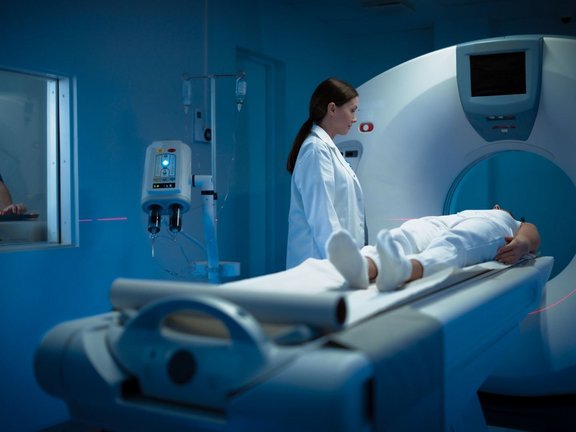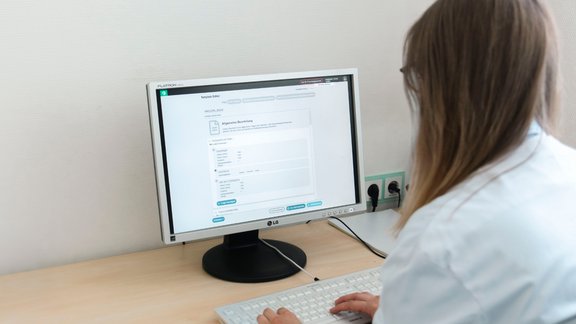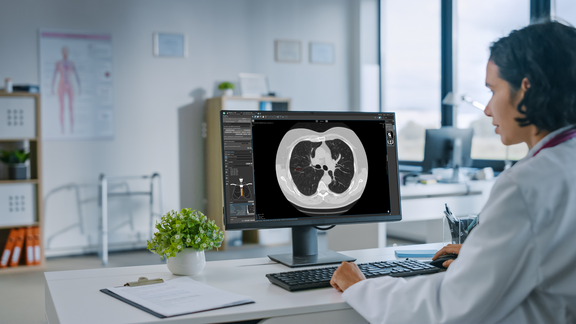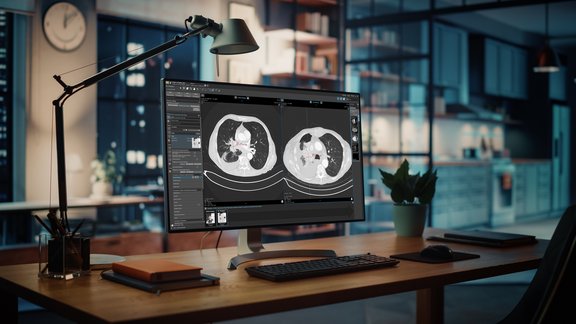Modern radiology faces a central question: how can imaging and clinical data be combined in a way that leads to more precise diagnoses, better-informed decisions, and more individualized treatments?
The RACOON network – a collaboration of all German university hospitals within the Network University Medicine (NUM) – provides answers. It demonstrates how interdisciplinary research, structured reporting, and intelligent data infrastructure together pave the way for a new era of data-driven medicine.
Whether rare sarcomas, pediatric lymphomas, adenomyosis, or liver cancer – the RACOON projects are united by a common goal: more structure, more comparability, and more knowledge for better therapeutic decisions.
Below, we offer insights into selected projects that exemplify how RACOON is shaping the future of clinical research.
RACOON-SAGA: Better Characterization of Rare Tumors
Rare tumors such as soft-tissue sarcomas pose unique challenges: their heterogeneity makes precise diagnostics difficult – directly impacting therapeutic decisions.
The RACOON-SAGA project addresses this by improving the pre-treatment characterization of sarcomas. It aims to correlate radiological parameters, especially the Apparent Diffusion Coefficient (ADC) from diffusion-weighted MRI, with histopathological grading.
In her interview, Dr. Madelaine Hettler (University Medicine Mannheim) confirms:
“Early studies have already shown promising results.”
Close collaboration between radiology and surgery creates an interdisciplinary workflow that makes grading rare tumors more transparent and reproducible. RACOON enables cases to be aggregated nationwide, allowing for “statistically robust conclusions,” Hettler emphasizes.
RACOON-RESCUE: Standards for Pediatric Non-Hodgkin Lymphoma
In pediatric oncology, standardized processes are essential for improving quality.
RACOON-RESCUE aims to improve diagnostics and follow-up for pediatric Non-Hodgkin Lymphoma (NHL) by combining structured documentation with AI-based analysis. To achieve this, clinical data from the NHL-Berlin-Frankfurt-Münster (BFM) registry is integrated with imaging data from all German university hospitals.
Study leads Prof. Diane Renz (Hannover Medical School) and Prof. Wilhelm Wößmann (University Medical Center Hamburg-Eppendorf) highlight the importance of the project. According to Prof. Renz, it creates a
“unique, representative, multimodal dataset [...] that can be used for predicting therapeutic response.”
Prof. Wößmann adds:
“RESCUE establishes the foundation for standardized radiological reporting and an automated image analysis workflow in the radiological diagnostics of pediatric NHL patients.”
RACOON-RESCUE showcases how structured data collection can transform existing datasets into new diagnostic standards, while ensuring data privacy, scalability, and quality.
RACOON-FADEN: Early Detection of Adenomyosis
For gynecological conditions such as adenomyosis, there is an urgent need for earlier and more reliable diagnosis.
RACOON-FADEN addresses this by developing an early detection tool that works independently of the examiner and produces standardized results.
To achieve this, cycle-dependent MRI exams are conducted - comparing, for the first time, healthy volunteers with symptomatic patients to identify early markers of the disease.
Prof. Sylvia Mechsner (Charité Berlin) explains the significance of this standardized tool:
“Currently, there is often a diagnostic delay of up to 10 years. Menstrual pain is dismissed as normal [...] and the affected women are not offered appropriate treatment.”
Prof. Matthias May (University Hospital Erlangen) adds:
“We wouldn't be able to conduct this study if the NUM RACOON infrastructure and the NUM-NUKLEUS didn't already exist.”
FADEN relies on key RACOON technologies: mint Lesion for structured reporting, MEVIS for volumetric segmentation, and DKFZ for intelligent motion correction, creating a methodologically groundbreaking approach for women’s health imaging.
RACOON-MARDER: Making the Invisible Visible – Earlier HCC Risk Detection
Hepatocellular carcinoma (HCC) is a potentially deadly cancer. Prognosis depends heavily on the timing of diagnosis – early detection allows curative interventions.
RACOON-MARDER aims to enable earlier intervention through AI-supported risk stratification based on MRI imaging and clinical data.
Prof. Timm Denecke (University Hospital Leipzig) explains:
“AI 'makes the invisible visible' and can extract what is essential to determine a patient’s risk – to see where a malignant process may be developing.”
The goal is to identify high-risk patients and provide them with intensified, MRI-based screening, both medically meaningful and economically feasible.
This project also leverages the nationwide RACOON infrastructure:
“NUM-RACOON is ideally suited to collect and consolidate imaging and clinical data from across Germany – I am not aware of any comparable network.,” Denecke summarizes.
Mint Medical’s Role in RACOON
For a network like RACOON to function, a common data language – and a system capable of speaking it reliably – is essential.
This is where Mint Medical comes in.
With its software platform mint Lesion, Mint Medical provides the backbone for structured reporting, data standardization, and interoperability within RACOON.
mint Lesion enables clinicians to capture clinical and imaging data in a structured, guideline-compliant, and reproducible manner. Radiological reports are transformed into machine-readable, interoperable data, forming the basis for research, AI development, and multicenter collaboration.
This turns multicenter research into a process that is not only possible, but efficient, reproducible, and scientifically robust.
Common Ground: Structure, Standards, Scalability
The RACOON projects clearly show how structured reporting, connected research, and artificial intelligence together set new standards.
RACOON provides the technical and organizational foundation for secure, standardized, and cross-site use of medical data.
Tools such as mint Lesion, MEVIS, and DKFZ-JIP enable harmonized workflows and interoperable data structures – from clinical practice to research.
This makes radiology the data engine of a more precise, patient-centered medicine.
RACOON stands for what modern medical research needs:
- Collaboration instead of silos.
- Structure instead of chance.
- And data that truly makes a difference.
For more information about the projects, feel free to contact us – or visit the NUM website.



